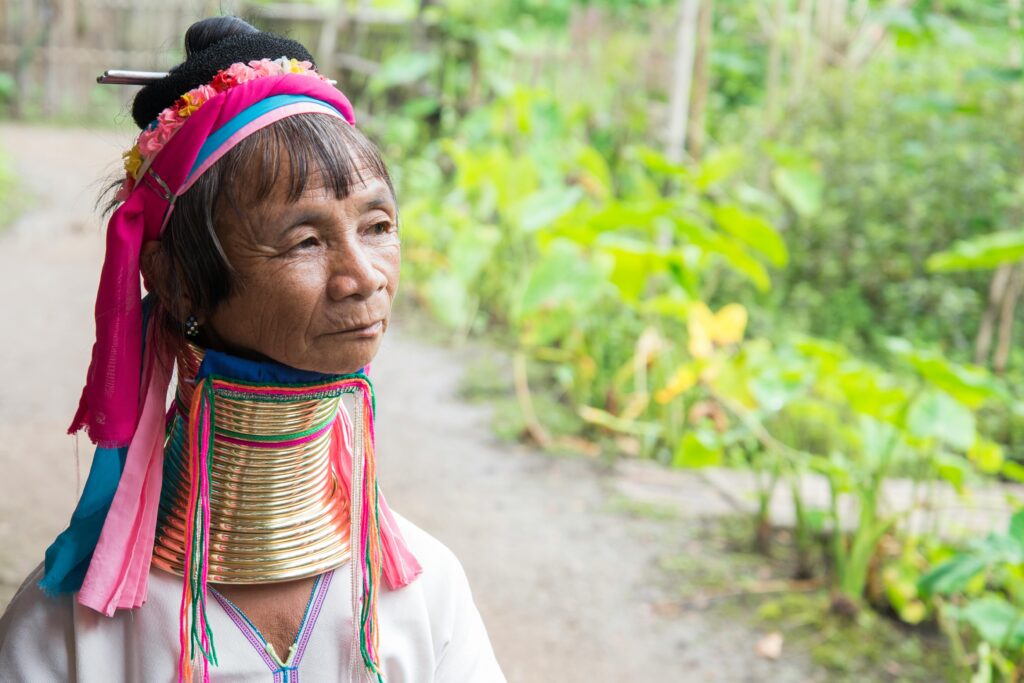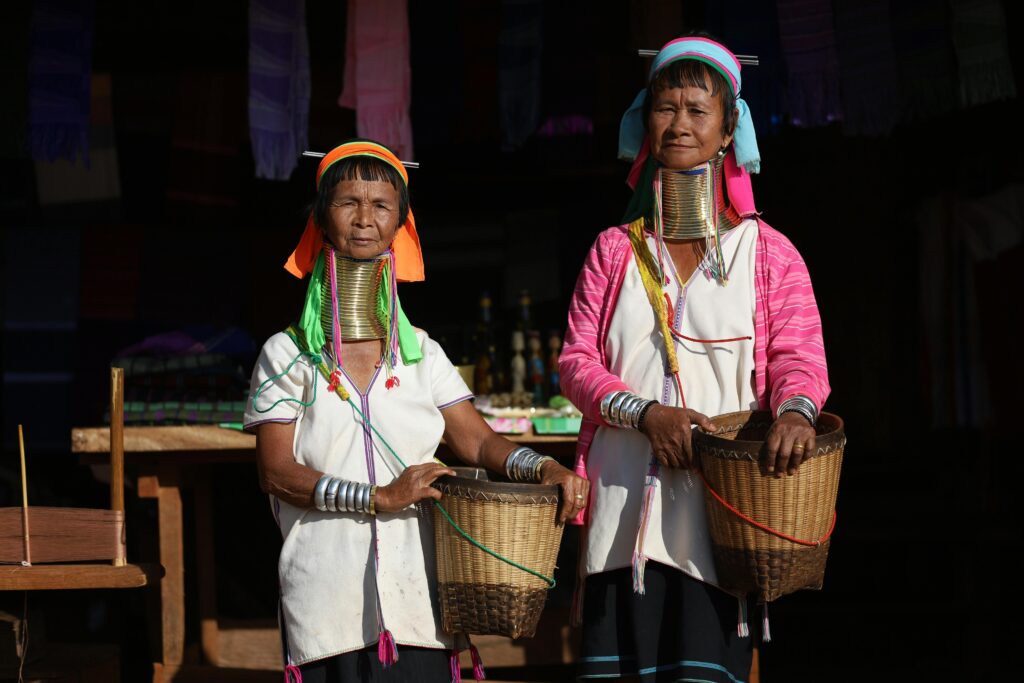Introduction
The Karen-Padaung tribe, often associated with the striking visual of “long-neck” women wearing golden neck rings, has long been a source of fascination for tourists in Thailand and Burma. However, beyond the visual intrigue lies a complex and often misunderstood community with rich traditions and struggles against cultural exploitation. This article explores who the Karen-Padaung are, the ethical questions surrounding their portrayal in tourism, and ways travelers can engage responsibly.

Table of Contents
Introduction
Have you ever wondered about the cultural stories behind those “long-neck” photos from Thailand? The Karen-Padaung, a subgroup of the larger Karen tribe, are famous for their unique neck rings, which have captured global attention. But there’s much more to their story than the visuals of elongated necks. This article dives into the rich history, cultural significance, and frequently asked questions about the Karen-Padaung tribe, exploring what ethical tourism means for them and how we can engage responsibly.
Who Are the Karen-Padaung?
The Karen-Padaung people are an ethnic minority from Myanmar (Burma) and Thailand, often known as the “long-neck” tribe due to their tradition of wearing brass coils around the neck. This practice, which begins at a young age, gives the visual effect of an elongated neck, though it’s the collarbones, not the neck itself, that are lowered. These coils are traditionally worn for beauty, cultural identity, and protection—originally thought to protect against tiger attacks in the forest.
A Brief History of Displacement
Conflict in Burma, particularly since the 1980s, has forced many Karen-Padaung to flee to Thailand. Here, they live in refugee villages and often rely on income from tourism due to restricted work options. While some appreciate the economic support, others feel their culture is exploited.
Why Do Karen-Padaung Women Wear Neck Rings?
The neck rings, often seen as an exotic curiosity by tourists, carry deep cultural significance. Here’s what they mean to the Karen-Padaung:
- Beauty and Identity: For Karen-Padaung women, the rings symbolize beauty, elegance, and a strong connection to their roots.
- Cultural Pride: The rings serve as a proud marker of identity, setting them apart visually and symbolically from other tribes.
- Tradition and Continuity: Wearing the rings is a tradition passed down through generations, a practice that helps younger Karen-Padaung feel connected to their ancestry.
The Impact of Tourism
In Thailand, the Karen-Padaung tribe are featured in “cultural villages,” where tourists can observe their way of life. While these attractions provide income, they also risk reducing a complex culture to an exotic display. Many question whether these villages honor Karen-Padaung heritage or simply exploit it. The ethical debate around these practices continues, with advocates pushing for more autonomy and respect for the tribe’s traditions.
Life Beyond the Tourist Gaze
Beyond tourism, the Karen-Padaung tribe face daily challenges, from limited economic opportunities to the struggle of younger generations who may feel disconnected from their heritage. Efforts within the community aim to preserve tradition while adapting to modern pressures, ensuring that their culture survives in a meaningful way.
Human Rights Issues
Forced displacement due to conflict has severely impacted the Karen-Padaung tribe, stripping them of homeland, resources, and rights. Living in tourist settings limits their access to diverse opportunities, keeping many economically dependent on tourism. Health concerns from cultural practices like neck rings also highlight the physical toll that restricted movement and isolation can have on well-being.

Toward Ethical Tourism
For those looking to engage with the Karen-Padaung tribe respectfully, there are steps to take. Travelers can prioritize ethical tourism by seeking out experiences that respect and empower the community. NGOs and local groups are working to improve conditions, but greater awareness among visitors is essential to create sustainable, supportive interact.
Frequently Asked Question: Do the Rings Actually Lengthen the Neck?
Despite popular belief, the neck itself is not lengthened by the rings. Instead, the weight of the coils presses down on the collarbone, which can give the appearance of a longer neck. This tradition is a physical sacrifice but one embraced by many women who wear the rings as a badge of cultural pride.
The Role of Tourism: Help or Hindrance?
Tourism has both positive and negative impacts on the Karen-Padaung tribe. In places like northern Thailand, Karen-Padaung villages have become major tourist attractions. Visitors pay to take photos with women wearing neck rings, creating a “human zoo” effect that some activists criticize as exploitative.
Tourism’s Economic Influence
While tourism provides financial resources to a community with limited employment options, there are significant ethical questions. Many Karen-Padaung would prefer to participate in tourism on their own terms—by sharing their culture, not being displayed as exotic spectacles.
- Positive: Income generated from tourism can improve village infrastructure and provide better access to health and education.
- Negative: The “cultural village” concept limits opportunities, often making tourism the only viable income source. This dependence restricts economic growth and freedom.
Ethical Tourism: How Can We Visit Responsibly?
Respectful, ethical engagement with indigenous communities, like the Karen-Padaung, is key. Here are some ways tourists can help ensure a positive experience:
- Choose Reputable Tours: Seek tours that respect and empower the Karen-Padaung and give back to their communities.
- Support Fair Trade and Artisan Work: Buy directly from Karen-Padaung artisans rather than from commercialized markets where they may not see a fair share.
- Learn First, Visit Later: Educate yourself on their history and traditions, so your visit becomes a way to show respect rather than curiosity.
Frequently Asked Question: Can the Karen-Padaung Remove Their Rings?
Yes, women can remove their neck rings if they choose to. Some Karen-Padaung women decide to take them off permanently, while others prefer to keep them as part of their identity. Decisions around wearing the rings are deeply personal and can vary depending on family, age, and individual preference.
Human Rights Concerns
The Karen-Padaung’s reliance on tourism raises human rights issues. Many live in restricted areas where work options are limited, and they often depend on tourism income. Here’s what their circumstances look like:
- Limited Work Opportunities: Living as refugees in Thailand, Karen-Padaung people are often legally restricted from working in fields outside of tourism.
- Health Impacts: The neck rings can lead to physical discomfort and health issues over time, as wearing the coils for extended periods may affect muscle strength and spinal health.
- Lack of Autonomy: Some villagers feel forced into tourism roles that display their culture superficially rather than genuinely sharing it.
Toward a Better Future for the Karen-Padaung
Looking forward, there’s potential for improvement in how the Karen-Padaung engage with tourism. Here are some suggested ways to support their autonomy and create a more ethical experience for all:
- Education and Skill Development: By investing in education and training, Karen-Padaung individuals could gain access to diverse work opportunities.
- Collaborative Tourism Initiatives: Initiatives that give the Karen-Padaung control over tourism projects allow them to tell their story in their words.
- Advocacy for Legal Rights: Ensuring that Karen-Padaung refugees have work rights and protections can lead to a more sustainable lifestyle beyond tourism.
Conclusion
The Karen-Padaung’s story is one of resilience, identity, and the desire for self-determination. While their culture is often simplified for tourism, deeper understanding and ethical engagement can support their autonomy. Respectful tourism can enable visitors to contribute positively, preserving the tribe’s unique heritage while helping them forge a future on their terms.
External Sources:
- UNESCO on Endangered Cultures
- WHO: Health Impacts of Traditional Practices
- Human Rights and Burma’s Displaced Tribes
Share this content:

